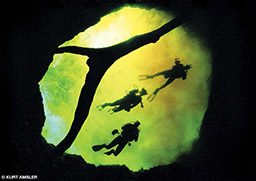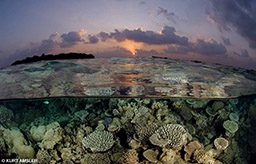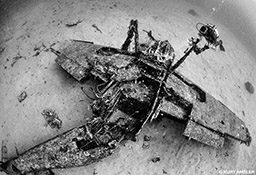Kurt Amsler may have inherited the photographer’s gene from his father, an alpine and outdoor photographer, but the inspiration for his eventual career as a marine photographer came from famed Austrian photographer and cinematographer Hans Hass. The year was 1958, and young Amsler was a child in landlocked Switzerland. By chance he picked up a copy of Among the Corals and the Sharks. The words and especially the photos that Hass took for this, his second book (published in Austria in 1941), were transformational for the young boy.

While on location in Bonaire, Hass had no rebreather, and the Aqua-Lung had not yet been invented. So he went underwater as William Beebe had described in his 1932 article “A Wonderer Under the Sea” for National Geographic magazine: with a homemade diving helmet. Amsler did much the same for his first underwater adventures in Lake Zurich. With a helmet cobbled together from wood and metal fittings and the help of a friend pumping air to him from above, Amsler could go as deep as 20 feet and stay for as long as he could stand the cold or his friend had the stamina to pump air to him. He could breathe underwater, he could see the fish, and, most important, he could dream of a life of ocean exploration.
When Amsler was in high school, his father bought him his first real gear for diving: a pair of fins and a mask. Now that he could see properly, the next step was to try to take photos underwater. After all, he had learned photography from his dad and had been helping him in their home darkroom since he was 10 years old. With a Leica camera housed in the bladder of a soccer ball and a bit of Plexiglas for a port, Amsler took his first underwater photo in 1959, thus embarking on a path he would follow for the next 57 years and beyond.
STEPHEN FRINK: You seemed to know at a very young age that underwater photography would be your life’s passion, but it must have been clear to you that you would have to travel beyond Lake Zurich. When did you venture out from home and begin to see the wider world of scuba diving?
KURT AMSLER: Some underwater photographers come to their careers by being scuba divers who learn to shoot. Then there are those like me who are photographers first and then learn to shoot underwater. After I finished high school I enrolled in the School of Art and Photography in Zurich. I was just 16 then and attended for four years, graduating with skills in studio photography, darkroom techniques, outdoor photography and portraiture. But the thought of doing more and better underwater photography was never far from my mind.
I bought my first Calypso PHOT camera with a bulb flash attachment in 1963, and finally I had quality gear I could use for underwater photography. Around the same time I bought my first Aqua-Lung tank and regulator from France, so I could actually dive and take pictures underwater without having to hold my breath or be tethered to the crude diving helmet we used in those early days.

SF: I saw a picture of you online recently. You were just a teenager, sitting in front of what seemed to be a caravan on a beach on the Red Sea. You were born in 1946, and in this picture you couldn’t have been more than 19. So that would put you diving the Red Sea in about 1965. That had to be a magical time in your life. Tell me how that came to be.
KA: Inspired by Hans Hass and his 1952 film Under the Red Sea, I wanted an underwater adventure of my own in the Red Sea. For me, that meant hitchhiking from Zurich to Greece with one of my friends. We hopped a freighter that got us to Haifa, and from there we made our way to Eilat, Israel. We met some Israeli navy divers who let us stay in that caravan you saw in the photo. We were there for eight months, diving every day.
It was a glorious time to see the Red Sea; the water was so clear, and the reefs were magic. There was lots of soft coral and amazing tropical fish — many sharks, too! This was the height of adventure for a couple of kids. I had my cameras — the Calypso PHOT and my Rolleimarin with the flash bulbs — but we had no money. I could play the drums, so I got jobs at night playing in a jazz band at the End of the World nightclub in Eilat. My friend was hired to yodel at weddings. That was quite a sight: a Swiss guy yodeling at an Israeli wedding. But somehow we managed to scrape together enough to stay. There were very few tourists there at the time. In eight months we saw maybe 100 tourists, and of those only 25 were divers. We had those reefs totally to ourselves — in places where the fish and turtles had never seen a diver before.
SF: I’m surprised that having been trained as a commercial photographer you didn’t want to move to London and be a fashion photographer like David Hemmings in the 1966 film Blow-Up. At that time there had to be a lot of work in many different fields for a skilled photographer with a portfolio from art school.

KA: I must admit there are parts of the Blow-Up lifestyle that would have appealed to me at that point in my life, but I remember very vividly standing on a beach in the Red Sea and having an epiphany. I knew for damn sure this was what I wanted to do with my life: underwater photography. I didn’t want to end up in a studio somewhere. The ocean would be my studio.
Yet it wasn’t that easy to make it happen. I was derailed for a short time to do my military service in the special forces of the Swiss Army. Then I started doing the travel circuit, showing the 16mm underwater films I’d shot to local dive clubs. I also began to get some of my underwater photos published in magazines. There weren’t any dive magazines in Europe at this time. You had Skin Diver in the USA, but my first published photos were in larger circulation, general-interest magazines, and their readers hadn’t really seen the underwater world before. My photos were a revelation to many who didn’t know such beauty and color existed beneath the sea.
My plan was to have one foot in the dive industry and one foot in photography. I became a dive instructor so I could easily get a job and support myself in places I might want to dive and take pictures.
In 1968 I met a pretty American girl who was on holiday in Switzerland and who also had a job as a secretary at the Holiday Inn in Freeport, Grand Bahama. She said I should come visit, and as I had never dived the Bahamas, a few months later I did just that. Coincidentally, a couple of years earlier the Underwater Explorers Society (UNEXSO) had opened up in Freeport with an innovative 18-foot-deep scuba training tank and a fleet of boats for diving their nearby reefs. This was the state-of-the-art in destination diving, and celebrities from all over the world came to train and dive there. Walter Cronkite did a story about it, and glamorous starlets such as Kim Hunter went there to learn scuba. Lloyd Bridges, who l had the pleasure to meet there, traveled there with his sons, Beau and Jeff, so they could learn to dive.
I had my portfolio with me, and I showed it to UNEXSO manager Dave Woodward. Few people were shooting serious underwater photos at the time, and Woodward was amazed. He said, “You must dive with us … maybe I can find you a job.” And he did. For the next two years I drove the dive boat when they needed me, and visitors gave tips to underwater photographers when they came around. The famous naturalist and dive guide Ben Rose became my best friend. And the diving was amazing. The shallow reef was solid with elkhorn coral, and we saw sharks and grouper on almost every dive. I learned a lot and made some great connections. While at UNEXSO I entered my first photo competition, in Santa Monica, Calif. I did very well and began to think I should compete in more contests.
SF: I read an interview with you written by our colleague Alex Mustard, and he said of your success in European photo competitions, “It is impossible to summarize the multitude of highlights in Kurt’s career here. Suffice to say that he has shot thousands of stories for magazines, written many books and photographed high-profile advertising campaigns. His competition record is also a full house. He won the 2nd CMAS [Confédération Mondiale des Activités Subaquatiques, or World Underwater Federation] World Championship in 1987, he was named Grand Master at the 1987 Brighton Festival that included the prize of a Rolex watch, his bookMaldiveswon the best book of underwater photographs at the Antibes Festival in 1994, and he has won awards in just about every other competition, including the BBC Wildlife Photographer of the Year.” Very impressive, Kurt!
KA: It is true I won almost every photo contest there was in those days. Contests were very popular in the 1970s and ’80s, typically organized by the Italians or the French and held all over the world. Usually they consisted of a three- to six-day shoot at some dive destination. I’d arrive with a model, shoot a lot and, mostly, win.

But it wasn’t about ego gratification; I wanted to have influence, and I needed to be famous for people to pay attention to what I was saying. By then I had been diving long enough to see changes in the ocean, and I wanted to make people aware of the need for marine conservation. I’ve always believed one-third of my time and one-third of my money should be spent giving back to the sea. My biggest campaign over the years has been to protect sea turtles, and now for 30 years we have been combating the harvesting of turtles for food and souvenirs. I was involved in closing dolphinariums and protecting sharks. More and more I have been fighting for animals on land as well. Recently I have become an ambassador for Sea Shepherd Global. They have power, and with power comes awareness. Together we can do great things to protect marine life.
SF: You have been active in commercial and advertising photography in the dive industry. I remember your early product ads for dive computers, which combined studio photo techniques in the underwater environment for product illustration.
KA: I met Dick Bonin, the founder of Scubapro, while at UNEXSO, and I used to shoot some of the very early lifestyle photos for their catalogs. I also enjoyed sponsorship from Nikon and Rolex. The composite images you now see coming out of computers, I used to do in real life, in the water. Many of these were big campaigns, paying $2,000 a day, and the shoots could go on for two or three weeks. That was really big money then, and not so bad even now!
You and I, we had the good times. We got to be underwater photographers when the scuba equipment became good enough to trust, the cameras and housings were good enough to capture quality photos, the dive infrastructure was maturing, and the reefs were unimaginably beautiful. Ours was the sweet spot in time.

When I was talking to topside commercial and editorial photographers at agencies such as Black Star, they always told me it was important to become a photojournalist. I had to be as good at writing as I was at photography, maybe better. This helped me when it came to doing books. I’ve published 14 books — five coffee-table books, five dive guides and assorted underwater photo guides and such.
SF: I know you as a photo equipment innovator, and you have a close and visible relationship with Seacam these days. How did you evolve from your Rolleimarin to the digital cameras you use today?
KA: When I think back to the various cameras I used over the decades, I note the good reasons I had to move from one to the next. Actually, I am very loyal to my gear. I have dived with Scubapro equipment for 45 years, and I’ve used only Nikon cameras since 1975.
My first self-made housing was pretty easy to move up from. I know what I like in an underwater housing, but I am not a brilliant machinist or housing manufacturer. Even the Calypso PHOT was a huge improvement over the crude housing I began with. But I knew to get the fish portraits I wanted that I needed greater compositional accuracy than cameras of the Nikonos design could provide. I needed the precision of reflex viewing. I will say that throughout my career, however, as long as I was shooting film, the Nikonos and 15mm lens would be with me on most every dive for wide-angle shots. Some of my favorite underwater photos were taken with that unique and venerable optic.

As a student I’d play drums in jazz bands to earn enough to satisfy my lust for camera gear. This took me (chronologically) from the Calypso PHOT to the Rollei twin-lens reflex camera in the Rolleimarin housing (coincidentally a Hans Hass design) to a Hasselblad in a Hugyfot housing and then a Bronica 2 ¼ square (also in a Hugyfot) during my medium-format era. In 1975 I headed in a different, more modern direction with 35mm film and a housed Nikon F2 with an action finder. I had the Oceanic Hydro 35 housing and Oceanic 2001 strobes. This was very good equipment, designed in the USA by Bob Hollis. When the Nikon F3 came out I went to Sea and Sea for the housing and strobes and then went back to Hugyfot when the F4 came out. I worked with them on the design of that housing, and it turned out beautifully.
When the Nikon F5 came out there was a reason to think differently about the housing design, because now there was autofocus. The idea of two hands always on the grips so one could continuously tweak focus was now obsolete. I wanted to free my left hand to hold the strobe as necessary, and Subal was more accommodating of my design ideas for that housing.
With my migration to digital in 2002, I made the transition to Seacam. They had a very nice housing for the Nikon D1X, and I knew I was never going back to shooting film. I wasn’t one of those guys who’d shoot half a job on film and half on digital, deciding later which I liked better. I waited to make the transition until the technology was already better than film, and I’ve never looked back. I’ve gone through many iterations of Nikon digital cameras, always with the corresponding Seacam housings, ports and strobes. At the moment I shoot the Nikon D3 and the D800. Right now we’re talking about manufacturing a Seacam housing for the new Leica cameras. If that happens, I will have come full circle, back to the brand of camera I shot for the first time in Lake Zurich so many years ago.

SF: You have always been a very active and fit person. Do you find it necessary for your job as an underwater photographer?
KA: Maybe it’s not necessary, but it’s certainly helpful — several times in my career I was awarded jobs over other shooters because they were 65 pounds overweight. How can you swim with whales if you can’t keep up, at least for a while? My dad was a very skilled athlete; in fact, he won the silver medal in gymnastics at the 1936 Olympics in Berlin. He was very good at the rings and parallel bars and remained active in mountaineering photography in his career. I was a black belt in judo, I’ve freedived to 115 feet, and for six years I was on the Swiss national windsurfing team. I still mountain bike, but my nondiving passion these days is solo-sailing my 28-foot boat.
At age 74 my father climbed the Matterhorn (one of the highest peaks in the Swiss Alps at 14,692 feet), and as I near my 70th birthday there is no question I’d like to be like my father. For him it was sport, sport, sport all the time, and he told me if your body is OK, your mind is OK, too.
Many of the things that have happened in my life have been significant events that shaped my future direction. I see turning 70 as one of those. I have taught underwater photography for 30 years (in fact, I have operated a school for underwater photography near my home on the French Riviera since 1995). But now I’m retiring from that part of my life. I still have my Seacam online academy (seacam-store.com/en/academy/the-equipment), but I’m moving on from hosting students. That particular chapter is done, but I look forward to the next ones.
While Amsler has enjoyed many triumphs in life, he experienced what he considers to be the apex of his career in 1984, when he served as cameraman and actor for a film called The Maldives: Paradise Transformed. His co-star was none other than Hans Hass, the man who first inspired him to peer beneath the sea to find his way in life.

Explore More
© Alert Diver — Q3 Summer 2016